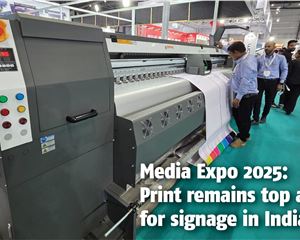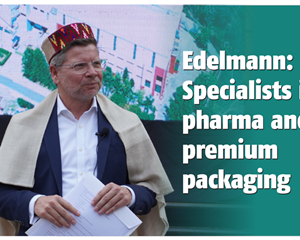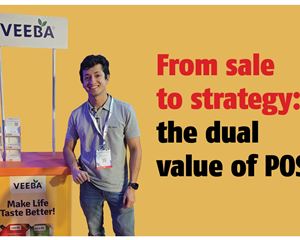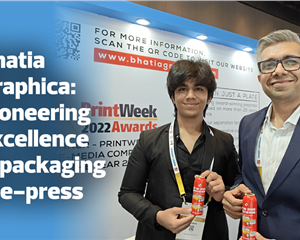ITC Packaging’s 92-year old journey began in Munger, Bihar to cater to its tobacco packaging requirement. The company has factories in Chennai and Haridwar. ITC continues to strengthen the position of being a heavyweight packaging frontrunner with pioneering investment in flexibles in 2008, labels in 2014 and now in corrugation, flexo and rigid boxes.
The PrintWeek India team spent two days at the ITC Limited - Packaging and Printing Division in Chennai. It is clear that your company is doing many things: from cigarette packaging to food and personal care and rigid boxes. The thing that is fascinating is to see that beyond the big business, the ITC team is creating new packaging products that are built specifically for the India market. Your views on these innovations?
Industries across the spectrum of consumer packaged goods consider packaging to be a key differentiator for their brands. We now see even the traditional segments like incense sticks, herbal cosmetics, ghee, etc use packaging extensively to help provide this differentiation. Value-added packaging is no longer restricted to segments like alcoholic beverages or high-end personal care products. Whatever be the end-use industry, there is a continuous focus on innovations in packaging. This is two fold – one at the higher end involving R&D in materials and alternative forms of packaging and another is low cost innovation for quick hit results using value addition.
What is your perspective about the Indian packaging industry and the potential for growth? The market data suggests: processed food packaging represents 48% of the total pie, personal care packaging is 27%, pharma is 6%, plus there is tobacco and liquor. How should a packaging firm invest? Create a market and invest; or invest and then create a market? Should one create or follow?
Both routes are relevant depending on the context. For traditional segments like cartons and flexibles you need to keep investing, creating capacity and target aggressive growth. However, for segments which have future potential for growth say like packaging for agricultural produce, fresh fruits, ready-to-shelf packaging etc, you may need to invest ahead of time and enable the market growth.
One of the things that impressed me was the "people strength" at ITC. What kind of HR policy does ITC possess to motivate its task force?
ITC is known for its holistic approach to human resource management. We look at hiring people from technical and packaging institutes and give them responsibilities early in their careers. We provide opportunities for cross functional experience and job rotation. We offer quality work environment, competitive salary and benefits that outweighs competition. We follow our core values of trusteeship, customer focus, respect for people, innovation, excellence and nation orientation in everything that we do and that keeps employees aligned to the business.
ITC invested significantly in building two state-of-the-art manufacturing locations. There is a tremendous amount of technology momentum. How do you juggle between upgradation of technology and return on investment?
ITC has always believed in investing in state-of-the-art technology keeping a long term perspective and providing the customer with superior solutions with technology and quality. Our choice of technology has always been with a futuristic outlook and benefitting customers.
How have you harmonised the process between your manufacturing locations?
We induct the technology in one plant and replicate the same in other plants. We have multiple technology platforms across plants integrated by common systems and processes.
Today there are a lot of options for a printing company in terms of choices. On the one side there are the traditional German, Swiss and Japanese heavyweights and on the other side, the influence of China plus new territories countries like Taiwan and Brazil. How do you pick and choose?
Investment in technology is for the long term. Hence, we prefer to look at solutions which are at the forefront of technology. For example, we were the first to invest in the Bobst Asitrade inline microfluting equipment though the same function could have been by a lower cost Asian-make alternatives using multiple processes. This helped us cater to large volumes with consistent quality and shorter lead times.
What about small operations?
For small value-addition machines and some niche areas we do look at lower cost technology options.
You have an interesting concept in place with the packaging design studio. This is a consumer-oriented approach. How has your small and nimble team reaped dividends for you?
Creating a studio which showcases products and technology enabled us to create an environment where customers can engage extensively with our team and work on creative designs and packaging concepts. Ultimately, packaging development is about anticipating customer needs well and a small, nimble and efficient team servicing the customer can enable speedy development by aligning all the processes to deliver customer delight.
The role of Product Introduction Process (PIP) in ITC?
Product Introduction Process (PIP) team pioneers packaging innovations. The cross functional team uses a unique process to pilot the client's packaging requirements through its manufacturing system. This process has helped enhance the look and feel of many leading brands. The centralised team operating from Chennai integrates design and development needs of all the units to ensure seamless knowledge transfer required for executing it right at the very first time.
How did you create your QC lab? Especially since you are dealing with multiple substrates and thousands of products?Our in-house labs are equipped with testing equipment for measuring key attributes of the products that we manufacture. In addition, we leverage our state-of-the-art multi product testing facilities at ITC’s Life Sciences & Technology Center at Bengaluru which serves as a comprehensive R&D centre for testing and research facilities.
Amongst the various guidelines such as US Food and Drug Administration (FDA); the British Retail Consortium (BRC); and with special reference to print, the European Printing Ink Association (EuPIA) and tried and tested ISO, What are the certifications a firm should opt for?
Certifications are a means of reassurance of the standards in place. We are compliant to integrated management systems that encompasses quality and EHS. Our units are further certified for Social Accountability (SA 8000) and BRC –IoP, Sedex among others.
How must a packaging firm look at paperboard? The importance of grain direction, bendability, stiffness etc.
Knowledge of technical characteristics of substrates and materials is critical in packaging development. An understanding of processes at our plants as well as in customer’s machines is an integral part of the skill base in packaging design. Hence, this forms an important role in a packaging company.
How do you handle shorter runs? Especially, smaller sizes and special sizes?
Whether in offset or gravure we offer flexible manufacturing platforms which can cater to small runs and unique sizes. Of course a smaller run ends up being more expensive to the customer. However, we do offer customers the flexibility they need in run sizes.
Very few factories look at cutting edge quality. You follow the principle of direct printing with pre-cut board sizes; plus use superior tools and die-cuts. Your comments on this.
The right quality parameters like cutting quality and crease stiffness are vital to ensure good runnability on customer’s packing lines. Our customers have also been upgrading and investing in state-of-the-art high-speed packing lines thus increasing the demand with respect to the performance of the packaging material.
One of your colleagues mentioned you worked on lean journey. Can you tell us some more?
The nature of our business depends on generating internal efficiencies so as to remain competitive in the market while offering quality products. Some of the key initiatives using the lean methodology include - 5S, quick changeovers and reduction of waste.
Can you tell us some more about the 5S impact?
5S has helped us keep our factories clean and progress to high hygiene standards and efficiency. Quick changeovers have helped to increase machine utilisation, thereby offer small volume SKUs competitively to the customers.
How about the reduction of waste?
Our waste reduction initiatives look at waste from a holistic perspective covering many areas like reduction of motion waste, process waste, duplication of effort etc, thus making our processes more robust, sharper and efficient.
Your factory is dust-free. How does one reduce dust in the factory; especially in areas like die-cutting, which are prone to high dust levels?
The physical infrastructure and the quality of tooling and substrates ensure minimum dust on the shopfloor. The investment in the inline waste extraction systems and employee involvement in 5S help comply to product safety and hygiene standards.
One of the things you have aimed to do at your factory is mistake proofing. How can an SME packaging firm achieve zero error?
Fool proofing through technology across processes, zero defect campaigns and various continuous improvement initiatives are in place.
Which software are de facto, now? What do the brands insist on during their audits?
Customers look for integrity of design files since printed packaging carries branding, legal and statutory text. While customers do not insist on any specific software, it is always safer to stay with an integrated software solution that works across platforms. It is also pertinent to have good archival and retrieval systems to handle design files.
Specific product requirements and compliance are just two elements that are crucial for a brand. A pharmaceutical customer will want to see a factory full of similar pharma-type work. The question for you is, should one keep production lines separate because the use of a substance that is suitable on, say, a bottle label might not be appropriate in a food label factory because of issues such as migration? Or it can be a mix and match?
We have been able to manage the complexity through the modular concept and yet retain focus on each of the product lines within the same factory.
Some converters in Europe are running digital presses or end-of-the-line finishing in the packer-filler sites. Will this scenario be replicated in India, too?
Yes, we do see a rise in the usage of end-of-the-line single-colour digital print for coding and serialisation for statutory requirements and consumer promotions.
How do you view digital printing and converting in folding carton as the way forward in the near future?
The packaging companies have started experimenting with digital technology to create customised or personalised packs that connect with changing consumer preferences. The technology has evolved over the years and is gradually becoming affordable for the packaging segment. In the near future we see this platform increasing in use, however the mainstay in technology will continue to be the conventional platforms.
What kind of automation in printing and post-press would a company like ITC opt for?
ITC has looked at automation primarily as a tool for enabling quality of the product and enhancing safety standards for operations.
How do you select your suppliers (ink, machinery, software)?
We work with leading suppliers who are reliable and are able to work with us in meeting current requirements and future market needs. We believe that our suppliers are critical partners in our journey of growth and success.
ITC Packaging follows the culture of innovation in packaging. How has this made your company a market leader?
In an increasingly competitive environment of capturing shelf space and consumer engagement, ITC Packaging made an early start and worked with customers to introduce features like tactile feel and other special effects across processes.
ITC continuously provides value addition options and anti-counterfeit solutions to customers?
There are numerous instances of innovative solutions given to customers and these have been recognised with several national and international packaging awards.
The Smithers Pira packaging consultant Dominic Cakebread has said paper and board is “an unloved backwater of packaging”, adding that much of the focus of R&D goes on plastic and “not so much on paper”. You have tried to counter some of this through glow in the dark packaging or XY and Z–axis packaging. What has been the response from the market?
The response from the market has been very positive and encouraging as it has helped our customers enhance their brand value.
Finally, where do you see ITC Limited - Packaging and Printing Division over the next 10 years?
ITC will continue to track customer needs and future market opportunities and invest ahead of the curve.
We will engage in new product development, deploy cutting-edge technology, focus on operational efficiencies and provide innovations through science-based R&D for future growth.
In an increasingly environment conscious world, another area of focus will be sustainable and recyclable solutions in packaging.
ITC will endeavour to be the market leader in the chosen segments in packaging.














 See All
See All